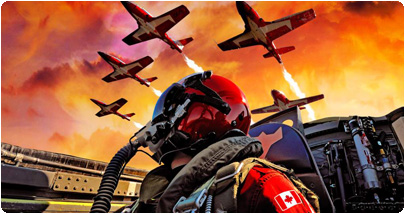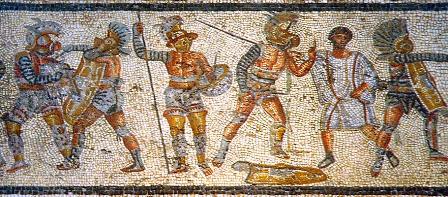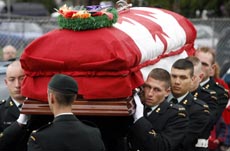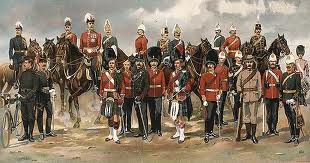A superior pilot uses his superior judgment to avoid situations which require the use of his superior skill.
– Frank Borman, Apollo 8
With jet engines blazing fuel in tight formation against the backdrop of a blue sky, the Canadian Snowbirds proudly represent the Canadian Forces (CF). No other military demonstration conveys quite the same electric fascination. They are an institution at the Canadian National Exhibition every September. Snowbird pilots barrel roll their CT-114 Tutor jets with dizzying accuracy, treating thousands of onlookers to the visceral joys of coordinated flight. As the 431 Iroquois Squadron, the Snowbirds are dubbed the “Warriors of the Air” and celebrated their 75th season last year. The squadron is an important feature in the history of the Royal Canadian Air Force and an essential link between the public and the armed forces.
[captionpix align=”left” theme=”elegant” width=”340″ imgsrc=”http://natoassociation.ca/wp-content/uploads/2013/06/snowbirds2.jpg ” captiontext= “”]
The Experience
As a national icon on an extensive touring schedule, the Canadian Snowbirds perform shows across North America and occasionally in Mexico. Once in the air at the beginning of a performance, the pilots fly in a Triple Vic formation (planes flying 3 by 3) to calibrate their timing and mentally prepare for the upcoming stunts. Each pilot performs an inverted roll out of the formation and proceeds to a 5G climb followed by a -2G dive. During the show, a variety of barrel rolls, dives, and loops are performed, often giving the illusion that a catastrophic collision is imminent. At a show in Montana last year, several people in the audience commented on the brilliance of a move called “The Firecracker” where the planes rolled in sequence only inches apart from each other creating the effect of fireworks lighting up the night sky. While the stunts are adrenaline-inducing, Snowbird 9 pilot Captain Brent Handy insists that all the pilots stay calm under pressure: “normally you kind of get in a groove and you just go with your training.”
A Brief History
The earliest Canadian aerobatic teams were the “Siskins” of the 1930s and the Golden Hawks and Golden Centennaires of the 1950s and the 1960s respectively. These teams dazzled with their technical sophistication but always struggled to maintain funding. The modern Snowbirds first performed in July of 1971 and were officially established on 1 April 1978 as the 431 Squadron, which had its roots as part of the World War II Bomber Command.
The Snowbird name was the result of a 1971 contest at the CFB Moose Jaw base elementary school. In the same year, the Canadian public positively responded to the Snowbirds after they appeared at air shows in Abbotsford, BC and at the Canadian National Exhibition in Toronto. During the 1990s, Major Bob Stephan and Major Dean Rainkie led Snowbird teams to hundreds of shows in the United States including a performance with the U.S. Navy Blue Angels during Disney’s 20th anniversary celebration. By their 25th anniversary in 1995, the Snowbirds had presented at more than 1575 shows to over 85 million spectators. Recent appearances at the 2010 Grey Cup and the 2011 NHL heritage classic affirm the Snowbirds commitment to supporting Canada’s sporting culture.
Top Guns
With fewer links connecting Canadians to the CF, the Snowbirds are a precious tool to remind Canadians of the important functions and role undertaken by the military.
When the Canadian Snowbirds perform, they provide an opportunity for the CF to showcase their talent. Major General Eichel calls the aerobatic team “a national icon” and highlights the visibility of the Snowbirds as a valuable recruiting tool. Lt. Col Dempsey agrees and declares that there is no other similar medium “in our entire nation.” Both highlight the skill of the Snowbirds in inspiring young people to contribute to the CF. Simply put, they are the top pilots in the country.
The Snowbirds are not only pilots but act as public representatives and ambassadors for Canada and the CF. In addition to their flying skills, they are selected for their interpersonal skills and ability to handle media attention. Each pilot is expected to tour the country and visit hospitals, schools, churches and other public places. Critics of the Snowbirds point out that their demonstrations glorify the brutal aspects of war and serve as a distraction from the conflicts the CF are engaged in. Others argue that the Snowbirds appearance at overly commercialized events serve only as a recruitment tool and opportunity for the CF to sell equipment.
Both of these criticisms fall short of their mark. In the case of glorifying war, the Snowbirds are not attempting to make a judgment on the validity or futility of engaging in combat, for their purpose actually highlights the skills one can obtain from the military regardless if they are used in a combat role. War needs no glorification, for its obvious negative consequences are well publicized in media outlets. Secondly, it is doubtful the CF receives a mass influx of buyers at Snowbird events, because the average participant rarely makes impulse decisions to purchase machine guns or expensive military vehicles. On the recruitment aspect, the criticism is not necessarily valid, because the CF benefits from inspired young people wishing to make a contribution to the CF.
Up to 6 million people per year witness the Snowbirds, and it is the only aspect of the CF that reaches nearly every corner of the country, including the North. From coast to coast, the Canadian Snowbirds remain the most inspiring, engaging, and exciting link between those that defend Canada and those who count on it to be defended.




